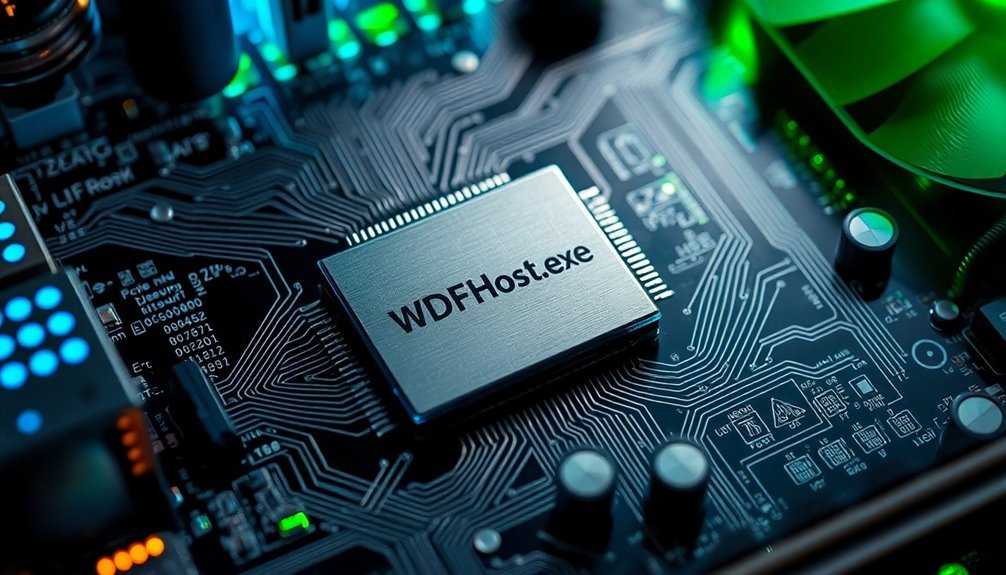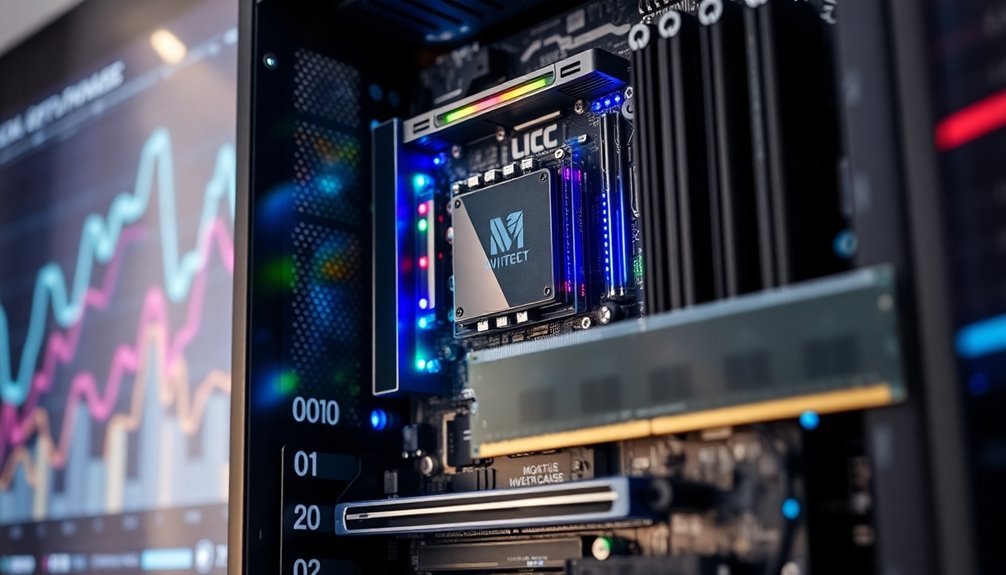Windows Driver Foundation High Memory Usage: Fix Driver Host Memory

If you’re experiencing high memory usage due to the Windows Driver Foundation and WUDFHost.exe, start by updating your device drivers. Running system checks like “sfc /scannow” can also help resolve the issue.
To rule out hardware problems, disconnect any external devices. Use Task Manager to monitor memory consumption and look for unusual patterns.
Regular maintenance, such as managing background processes, can keep memory use under control. Additionally, consider exploring effective tools and strategies to further optimize your system’s performance.
Overview of Windows Driver Foundation and WUDFHost.exe

The Windows Driver Foundation (WDF) is a vital framework designed for managing device drivers in user mode, providing a secure and stable environment for hardware communication. By isolating driver faults, WDF significantly enhances system stability and minimizes the chances of crashes. This robust framework offers an extensive array of libraries and tools that simplify and elevate the driver development process, especially for devices that communicate over protocols like USB.
A key component of WDF is WUDFHost.exe, which plays a crucial role in managing user-mode drivers. This system process facilitates seamless communication between device drivers and the operating system while maintaining kernel integrity. Depending on your operating system, WUDFHost.exe may run multiple instances to effectively handle various device stacks or pools. This executable is responsible for located in the C:\Windows\System32 directory, WUDFHost.exe supports essential functions such as interprocess communication and I/O dispatch.
By creating a clear separation between user-mode drivers and the OS kernel, WDF and WUDFHost.exe ensure secure and efficient hardware interactions. This framework is indispensable for the optimal performance of a diverse range of peripherals—including cameras, audio devices, and more.
If you’re looking for reliable solutions to improve your device driver experience, understanding WDF and WUDFHost.exe is essential.
Common Causes of High Memory and CPU Usage
If you’re experiencing high memory and CPU usage linked to the Windows Driver Foundation (WDF), it’s essential to understand the common causes that may be contributing to this issue.
One of the primary culprits is often outdated or corrupted drivers, which not only increase resource consumption but can also create conflicts, thereby forcing WDF to work harder than necessary. To resolve this, consider updating your drivers through Device Manager or by visiting the respective manufacturer’s websites.
Another potential cause of high WDF resource usage is hardware conflicts, especially with peripheral devices such as USB hubs. Malfunctioning or incompatible peripherals can place a significant strain on WDF. To troubleshoot, try disconnecting non-essential peripherals to determine if one of them is the source of the issue.
Additionally, background processes or third-party software can interfere with the normal functioning of WDF, leading to elevated CPU usage. Utilizing clean boot mode can help you identify any conflicting programs that may be contributing to the problem. Windows Driver Foundation issues can manifest due to these software conflicts, exacerbating CPU load.
Moreover, system file corruption or missing Windows updates can also result in abnormal WDF activity. To address these issues, employ tools like the System File Checker and ensure that all Windows updates are installed.
Symptoms and Impact of Excessive Resource Use
Excessive resource consumption by the Windows Driver Foundation (WDF) can significantly degrade your system’s performance and usability. If you’re experiencing issues, you might notice several symptoms, including:
- System Slowdowns: Increased CPU usage from WDF can cause noticeable lag, hindering your productivity.
- Higher Battery Drain: For mobile devices, WDF’s high memory consumption can lead to rapid battery depletion.
- Application Crashes: Spikes in WDF memory usage can destabilize your system, resulting in unsatisfactory crashes.
- Diminished Multitasking Performance: Limited memory can force you to prioritize essential applications, complicating your workflow.
These problems not only diminish your overall user experience but can also result in long-term hardware issues, such as overheating and a shortened device lifespan.
As WDF continues to draw on system resources, routine tasks like gaming and web browsing may become sluggish. Therefore, addressing excessive resource use is crucial to maintaining optimal system performance and ensuring a seamless user experience.
Diagnostic and Troubleshooting Steps
If you’re experiencing high memory usage by the Windows Driver Foundation (WDF), it’s essential to follow a series of diagnostic and troubleshooting steps to effectively identify and resolve the issue.
Begin by using the Windows Memory Diagnostic tool to check for faulty RAM, as defects in memory can significantly impact WDF performance. To do this, simply run the command, “Windows Memory Diagnostic,” and select the option to restart your computer for an evaluation.
Next, ensure that all your device drivers are up to date, particularly for Wi-Fi and peripherals, as outdated drivers can lead to memory leaks. Running Windows Update is crucial, as it provides patches that can enhance WDF efficiency and overall system performance.
In addition to these measures, conducting system integrity checks with commands such as “sfc /scannow” and using the Deployment Imaging Service and Management Tool (DISM) can help restore system stability and improve memory management.
Monitor WDF processes via Task Manager, paying close attention to any unusual memory spikes. For further diagnosis, you may want to temporarily disable**** the Windows Driver Foundation service to see if the high memory usage persists.
Lastly, consider disconnecting external devices to isolate any potential hardware issues contributing to excessive memory use. Reconnect them one at a time to pinpoint the possible culprit.
Following these steps can help you effectively diagnose and reduce high memory usage associated with the Windows Driver Foundation, improving your system’s stability and performance.
Practical Fixes to Reduce WDF High Memory Usage

To effectively reduce high memory usage related to the Windows Driver Foundation (WDF), consider implementing several practical fixes focused on driver management and system optimization.
Here are four essential strategies to enhance your PC’s performance and stability:
1. Update and Replace Drivers: Ensure your device drivers are regularly updated from official manufacturers.
Utilize tools like Display Driver Uninstaller (DDU) to remove problematic drivers completely before installing fresh copies, which can help mitigate WDF-related memory issues.
2. Manage Windows Updates****: Make sure your Windows operating system is fully updated with the latest patches.
Use the System File Checker (SFC) tool to repair any corrupted system files that could be contributing to high memory usage by WDF.
3. Optimize System Configuration: Limit the number of background applications that may interfere with WDF.
Review your startup programs to disable unnecessary applications that consume system resources right from boot-up.
4. Utilize Built-in Monitoring Tools**: Leverage Windows’ Event Viewer and Resource Monitor** to monitor driver-related errors and track memory usage.
This proactive approach can help identify errant drivers or processes that may be causing high memory consumption.
Additional Considerations and Ongoing Maintenance
After addressing high memory usage associated with the Windows Driver Foundation, it’s crucial to implement ongoing maintenance and consider further optimizations for improved system performance.
Regularly monitor driver host memory usage to identify any unusual spikes that may indicate memory leaks or inefficiencies. Utilize tools like Windows Performance Monitor and Resource Monitor to analyze real-time memory consumption effectively.
Proper memory allocation and deallocation are essential for drivers, so ensure you’re selecting the correct pool types based on your driver’s access needs.
Don’t forget to keep your drivers and Windows OS updated, as these updates often include performance enhancements and critical memory management fixes.
Consider adjusting system settings, such as virtual memory and page file management, to alleviate the impact of memory usage. Disabling problematic driver components can help isolate specific issues, while modifying Group Policy or registry settings may yield additional performance gains.
Always monitor your system’s behavior following updates to quickly identify any emerging memory problems. By implementing these ongoing maintenance strategies, you can ensure your system remains efficient and performs optimally over time.
Tools for Effective Driver Management
Essential Tools for Effective Driver Management to Enhance System Performance****
Effective driver management is crucial for optimal system performance and stability. By utilizing the right tools, you can streamline your driver management process and ensure seamless operation of your computer. Here are four essential tools for managing drivers effectively:
- Windows Device Manager: Harness the power of this built-in utility for fundamental driver management tasks. It allows for driver rollbacks and device status checks, making it a practical choice for everyday users.
- Driver Booster: This popular automatic updater features one-click updates and boasts a vast database of certified drivers. It’s a convenient solution for those looking to keep their drivers up to date effortlessly.
- AIDA64: For the tech-savvy, AIDA64 offers advanced diagnostics with comprehensive details on hardware and driver performance. It’s ideal for users who seek deeper insights into their system’s health.
- Driver Genius: Beyond driver management, Driver Genius proactively monitors CPU and GPU temperatures, ensuring overall system health while safeguarding driver integrity.
With these top tools at your disposal, you’ll be well-prepared to manage your drivers effectively, helping you prevent performance issues and maintain a stable system.
Optimize your driver management today for a better computing experience!
When to Seek Professional Assistance
When managing your drivers, it’s essential for maintaining optimal system performance. However, there are times when self-troubleshooting may not be sufficient. If you notice that WUDFHost.exe is consistently using high memory or CPU resources, despite applying basic fixes, it may be time to consider seeking professional assistance.
Symptoms such as frequent system freezes or crashes associated with driver operations can indicate more serious underlying issues. If you’re unable to resolve driver-related problems through Windows Update or built-in troubleshooting tools, it’s wise to reach out for expert help.
Other alarming indicators include decreased system performance during important tasks and unexplained system warnings related to drivers. Hidden malware or complex driver conflicts could also be at play, necessitating a professional evaluation.
Improper troubleshooting efforts can lead to system instability or loss of functionality, highlighting the importance of expert intervention.
In conclusion, if you’ve explored all possible solutions and continue to experience persistent driver issues, consulting professionals can’t only alleviate your frustrations but also help protect against potential data loss.
For more guidance on driver management and troubleshooting, consider reaching out to local tech support or looking for reputable online resources.
Frequently Asked Questions
What Is WUDFHOST.Exe Responsible for in Windows?
WUDFHost.exe manages user-mode drivers, providing a stable environment for device communication. It handles complex I/O operations, ensuring system security and reliability by preventing user-mode driver errors from affecting the kernel.
Can WDF Processes Affect Gaming Performance?
When it comes to gaming, WDF processes can indeed throw a wrench in the works. High CPU and GPU usage from them can lead to lag and stuttering, affecting your overall gaming experience.
How Does Outdated Hardware Influence WDF Resource Consumption?
Outdated hardware strains WDF resource consumption by causing compatibility issues. You may experience increased CPU usage and memory leaks due to frequent driver crashes and retries, leading to degraded system performance and frustrating user experiences.
Are There Any Risks When Uninstalling Drivers?
Yes, uninstalling drivers poses risks like system instability, hardware failure, and security vulnerabilities. You might lose essential functionality, encounter compatibility issues, or inadvertently expose your system to malware without realizing the consequences until it’s too late.
How Do I Check if My Drivers Are Compatible?
To check driver compatibility, open Device Manager, expand categories, and look for warning icons. Right-click problematic devices to update or view details, and verify using Windows Update or manufacturer websites for the latest drivers.
Conclusion
To summarize, managing the Windows Driver Foundation effectively can considerably enhance your system’s performance. Did you know that up to 15% of system memory can be consumed by inefficient drivers? By following the diagnostic steps and practical fixes outlined, you’ll not only reduce high memory usage but also improve overall efficiency. Regular maintenance and using the right tools can keep your drivers in check, ensuring your system runs smoothly without undue strain on resources.





